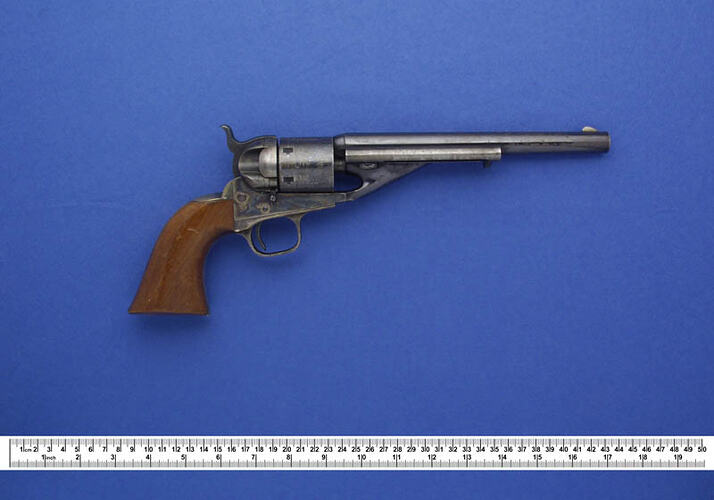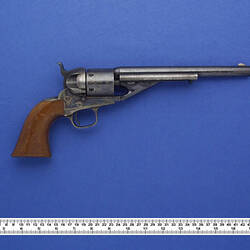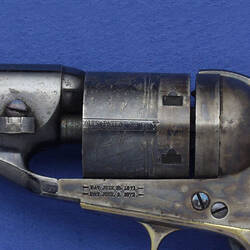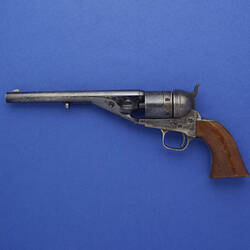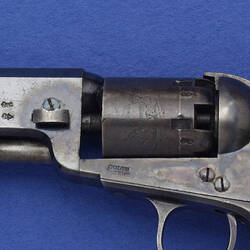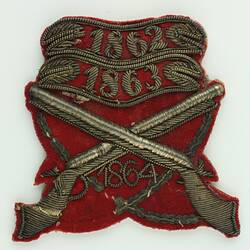Summary
Colt 1861 Navy revolver in original centrefire metallic cartridge configuration, cal. .38 in., using parts from a pre-cartridge model hence the original .36 in. stamping on triggerguard, rifled round barrel 190 mm (7 1/2 inch) with Mason-style side ejector.
Made by Colt's Patent Fire Arms Manufacturing Co, Hartford, Connecticut. Serial number 2071, 1862.
Barrel lug stamped with a James Rosier number of J.R 18633, indicating it has been through the business of prominent Melbourne gun retailer, James W. Rosier.
Physical Description
Six chambered cylinder engraved with naval battle scene, large rounded brass trigger guard with good remnants of silver plating, steel frame, brass back strap with light remnants of silver plating, wooden grips, blade front sight, loading gate on right hand side. Knurling on hammer is of typical London style framed in an inverted 'U'. Barrel address is one-line New York address. Serial number 2071, though cylinder is stamped 021. This is possibly a factory error, or alternatively indicates the original serial number of the cylinder. Cylinder and barrel underside stamped with British proof marks. Frame left hand side is stamped with the double patent stampings for C.B.Richards patent (top stamping, patent no. 117461) and then W.Mason's patent (bottom stamping, patent no. 128644). Strong case hardening colours to frame and good original blueing with some wear across cylinder and barrel.
Significance
The 1861 Colt Navy followed on from the 1860 Colt Army in general design and appearance with the obvious exception that it was produced in the Naval calibre of .36 in. rather than the Army's .44 in. It had a relatively short production of thirteen years with a total production figure of 38,843. Undoubtedly many more would have been produced were it not for the introduction of metallic cartridge ammunition and the disastrous fire at the Colt factory in 1864. Production of this model declined markedly after this date.
This particular example was produced in Colt's Hartford factory but destined for the English market, as denoted by the British roof marks on cylinder and barrel. Interestly this model is unlikely to have been converted to centrefire, but rather to have originally been produced to take metalic cartridge ammuntion, as indicated by the original circular knurling on the head of the ejector rod, rather than the course cross-hatching present on later factory conversions, and the fact that the double patent stamping on the frame left hand side is not stamped over the original COLTS/ PATENT stamp.
Such models highlight the developments that would occur from the 1860s onwards in producing firearms capable of accepting cartridge ammunition.
More Information
-
Collecting Areas
-
Acquisition Information
Donation from Miss L. Armytage, Oct 1957
-
Manufacturer
Colt's Patent Fire Arms Manufacturing Co, Hartford, Connecticut, United States of America, 1862
-
Retailer
James Watson Rosier (Gunsmiths), 66 Elizabeth Street, Melbourne, Greater Melbourne, Victoria, Australia
-
Inscriptions
Stamped on barrel: ADDRESS COL. SAML COLT NEW-YORK U.S. AMERICA. Stamped on cylinder: COLTS PATENT No. 987 Stamped on cylinder with British proof marks Stamped on L.H. side of frame: PAT. JULY 25, 1871./ PAT. JULY 2, 1872. Stamped on L.H. triggerguard triangle: 36 CAL Stamped on barrel lug: J.R/ 18633 Stamped on R.H. wooden grip: 10881 Serial No. - Cylinder: 021; Trigger guard: 2071; Frame: 2071; Barrel lug: 2071; Butt: 2071; Loading Gate: 4746
-
Model Name or Number
-
Brand Names
-
Classification
-
Category
-
Discipline
-
Type of item
-
Overall Dimensions
33.3 cm (Length), 3.5 cm (Width), 12.8 cm (Height)
Barrel length: 19.00 (7 1/2 in.)
-
Keywords
